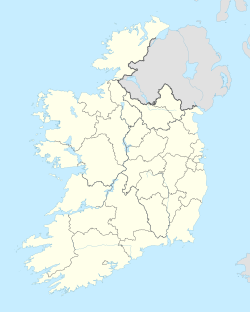National Science Museum at Maynooth
 Plaque at entrance | |
Former name | Museum of Ecclesiology |
|---|---|
| Established | 1934 |
| Location | Maynooth, County Kildare, Ireland |
| Coordinates | 53°22′43″N 6°35′55″W / 53.37857°N 6.59857°W |
| Type | Science museum Ecclesiology museum |
| Public transit access | Maynooth Dublin Bus routes: 66, 67 |
| Website | maynoothcollege |
The National Science and Ecclesiology Museum at Maynooth is a
The museum holds various artefacts from the history of science in Ireland (the largest such collection open to the public in Ireland),[1] a large collection of scientific equipment used by Nicholas Callan,[2] and one of two death masks of Irish political leader Daniel O'Connell.[3][4] The museum was founded in 1934 as the Museum of Ecclesiology but has become more focused on science, partially due to Maynooth's association with Callan.
History
The museum was founded in 1934 as the Museum of Ecclesiology in what was then simply
Collection
The museum has two main collections: a collection of scientific instruments associated with Nicholas Callan and a collection of ecclesiastical artifacts.
The Callan collection includes the first induction coil,
There is also a large holding of nineteenth century batteries in the museum. Other items in the collection include a Norremberg polariscope, a nineteenth century polarizing microscope, and the first portable GPS device.[citation needed] Navigation instruments are also displayed in the museum, including several octants and sextants. In 1731, the Hadley octant improved in design to become the forerunner of the modern sextant.[10] The octant inscribed with the name 'Yeates' in the collection appears to refer to a George Yeates, active from 1826-1858.[citation needed]
The museum's ecclesiastical collection includes a set of priestly vestments including a set of robes commissioned under the royal patronage of Marie Antoinette. They include an old Ecce Homo (12C) and a leaf of an ivory diptych (14C, Northern France). In addition there are a number of altar stones and a statue of Jesus that was defaced by Cromwellian soldiers during the Siege of Drogheda in 1649.[citation needed]
|
Access
The museum opens several days a week out of academic term, and by appointment from October to May.
References
- ^ "National Science Museum at St. Patrick's College, Maynooth". www.askaboutireland.ie. Retrieved 6 May 2016.
- ISBN 978-1898706014.
- ^ "National Museum Maynooth | Take five: 5 fascinating objects on display in the Museum". maynoothcollege.ie. Retrieved 6 May 2016.
- ISBN 978-0901519757.
- ^ "National Museum Maynooth | Just another WordPress site". maynoothcollege.ie. Retrieved 6 May 2016.
- ^ "BSHS Travel Guide - National Science Museum, St. Patrick's College, Maynooth, Ireland". www.bshs.org.uk. Retrieved 6 May 2016.
- ^ "The Classic Induction Coil, Induction, Coils, HV". www.sentex.net. Archived from the original on 30 October 2016. Retrieved 22 April 2016.
- ISBN 1-898706-02-6.
- ^ a b "RTÉ - Icons of Irish Science podcast online, show, free". Radioline. Retrieved 21 April 2016.
- ^ "The History of the Sextant". www.mat.uc.pt. Retrieved 22 April 2016.
Further reading
- Bowler, Peter J., Nicholas Whyte, and Queen's University of Belfast. Institute of Irish Studies. Science and Society in Ireland: The Social Context of Science and Technology in Ireland, 1800-1950. Belfast: Institute of Irish Studies, Queen's University of Belfast, 1997.
- McNeil, Ian, ed. An Encyclopedia of the History of Technology. Florence, US: Routledge, 2002.
- Shock and Awe: The Story of Electricity by Jim Al-Khalili








